Press F11 to
limit top toolbar
Press again for toolbar to
return
Sailing Ship
- Mystery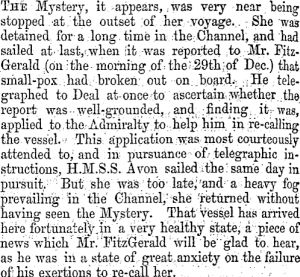
Mystery, a fine, powerful
ship of 1069 tons, was sent out by the White Star Company. It left London
in December 29, 1858, on it's maiden voyage that occupied five months and
owing to lack of proper food, 18 children died on board. The ship
encountered storms and calms and at times her progress was so slow that a
biscuit, tossed overboard at night was still alongside the ship the next
morning.She finally sailed into Lyttelton Harbour, Canterbury on
March 20, 1859, with the yellow flag flying and was quarrentined
until on April 2, 1859. On board were a party of 12 with
their families Deal boatmen whose suffering and destitution who had
previously created a stir in England. The men were presented with a
good boat and complete fishing gear to enable them to faih off
Lyttelton after arrival. Captain Matthews reported that soon after
clearing the land, smallpox and scarlet fever broke out, and before
reaching Lyttelton fifteen of the 300 immigrants on board had died and
been buried at sea. On arrival the ship was placed under quarantine.
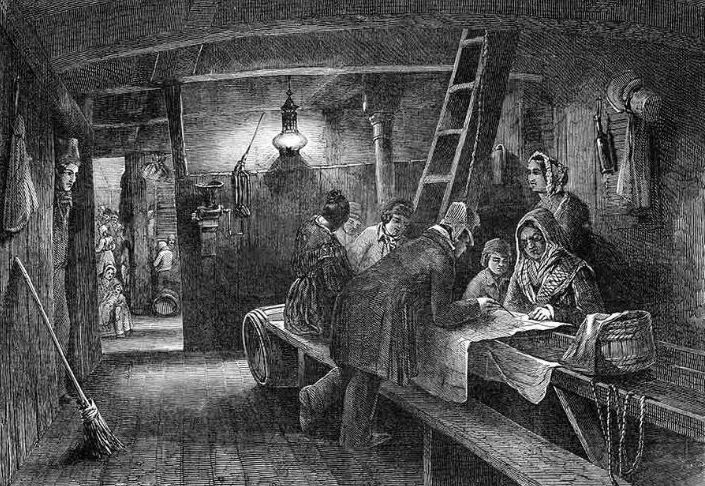
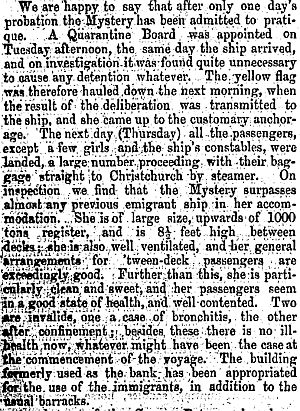 |
|
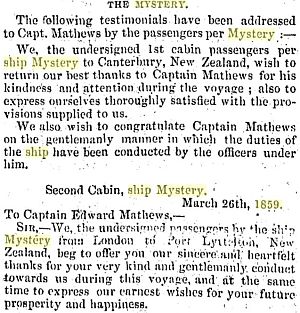 0 0 |
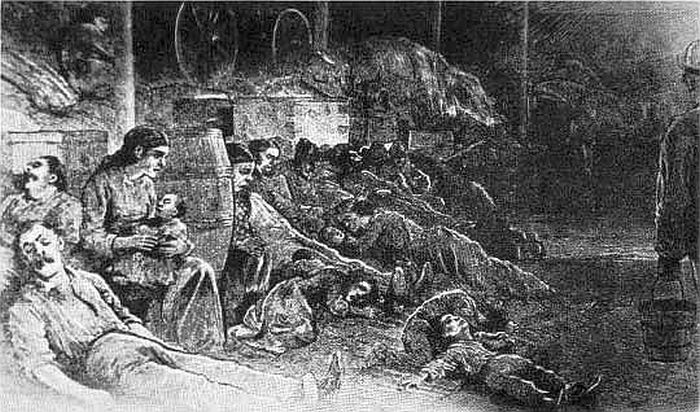
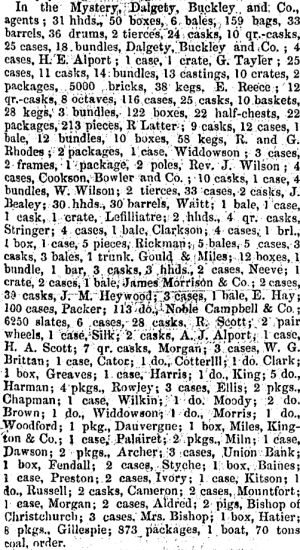
The Mystery made three
successful voyages to New Zealand with passengers and general cargo, src:
Brett's "White Wings." 1859 was her first voyage, she sailed into
Lyttelton Harbour on March 20, 1859, with the yellow flag flying.
Captain Matthews reported having sailed from London on December 29, 1858
but soon after clearing the land, smallpox and scarlet fever broke out,
and before reaching Lyttelton fifteen of the 300 immigrants on board had:
died and been buried at sea.
Each passenger had to be
equipped with enough clothing to last for some time - they were told,
there was no means of procuring goods in a place which boasted "only a
church and three hotels". The passengers landed and at Heathcote, they
received their first sample of milk for five months. During the voyage all
the drinking water, had to be strained through a muslin bag in order to
keep the insects out of the cups.
Between May and in
June, 1859, the Lyttelton Times advertised "Able Seamen wanted for the
ship "Mystery', to proceed to China. Apply to the Master on board. June
15th: The Mystery 1100 tons Capt E Matthews, sailed for
Shanhai
The Mystery made a second voyage
to Lyttelton in 1862 under the command of Captain Stapp. On this occasion
she sailed from London with 208 Government immigrants on October 18, 1861,
and arrived at Lyttelton on January 3, 1862, having completed another
smart passage of 80 days, port to port.
The Mystery, still under
the command of Captain Stapp, sailed from London with 85 passengers on
December 12, 1863, and arrived at Port Chalmers on April 17, 1864. She was
detained in the English Channel for 18 days by furious gales and did not
take her final departure until December 30
OLD SEA TRAGEDY - LOSS OF
SHIP MYSTERY. FIVE MONTHS ON VOYAGE.
Haul in the bow line To
keep the ship from rolling, Haul in the bow line. The bow line, Ho!This
good old sea chanty, heard over the wireless one night last week, brought
vivid memories to at least one Auckland listener, Mr. Alfred Clark, of
Pine Street, Mount Eden, who, 72 years ago, heard the sailors of tho old
ship Mystery chant tho same air as they hauled at the lanyards during the
five months' voyage from England. Such chanties are heard no longer on
shipboard and to a man like Mr. Clark, who is now 80 years of age, a
fleeting revival of their salty flavour is a rare experience to be
treasured with all reverence came to the Dominion on the vessel's first
voyage to the Antipodes and yesterday related the story of her eventful
passage from Tilbury Docks to Lyttelton. Deaths ol 18 Children. The ship
had a tragic history from the start. As she carried no fresh meat or milk,
and did not call at a single port' in the whole five months she was on the
voyage, illness broke out among the passengers and 18 children died. -"I
can still hear the bell that was tolled on beard when another body was
about to be consigned to the waves," said Mr. Clark. " The food was bad
and the biscuits were so hard you could not break them with the teeth. We
came round the Cape of Good Hope, and a good many hundreds of miles to the
south of it to get the benefit of the trade winds, but we were becalmed
for weeks in the tropics, the ship being almost stationary in the
water.When we reached Lyttelton we tasted fresh beef for the first time
for five months. It was delicious. But the poor old ship only made two
other voyages to New Zealand. then on the return journey to England, bore
out its sinister name by vanishing . She was a 'Mystery ship' to the end."
Swamp at Cathedral Square. On reaching Christchurch" there was a rush to
the barracks to secure work. Employment was to be obtained in
abundance/harvesting absorbing the majority of the men. Mr. Clark
remembers Cathedral Square when it was a swamp, covered with flax and
gorse, and he saw the foundation stone of Christchurch Cathedral being
laid.
   Images
and data used in this site copyright - ©
Images
and data used in this site copyright - ©
Descendant input to
up-date family pages is very welcome - more detailed information available
on
request
|